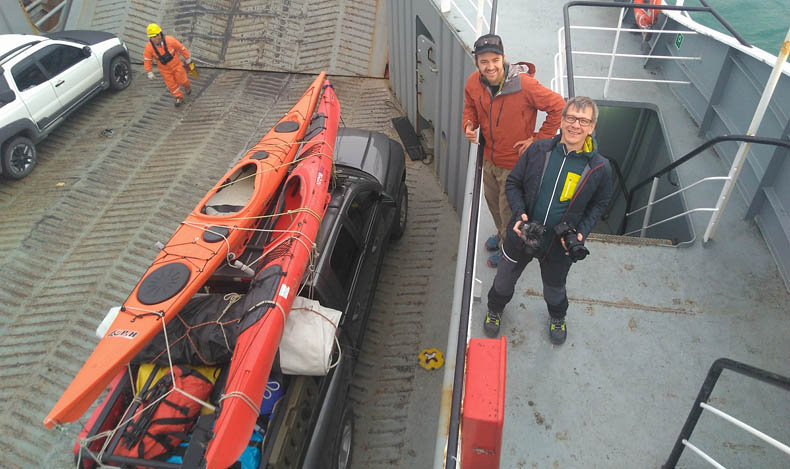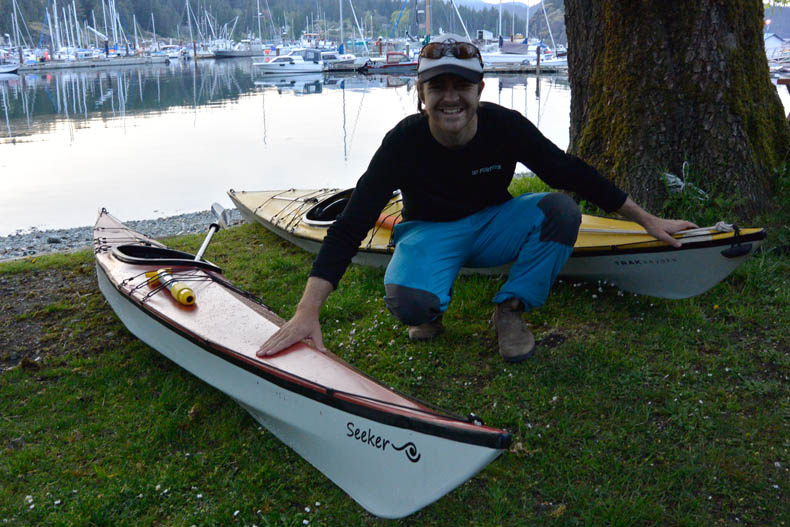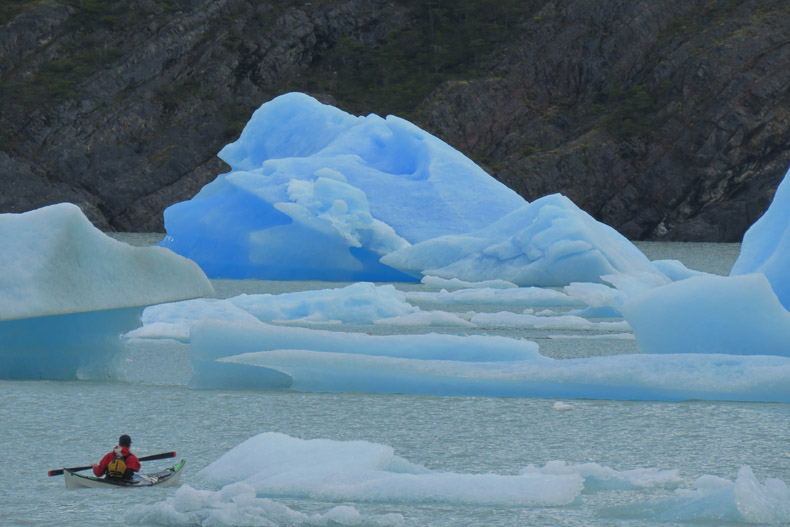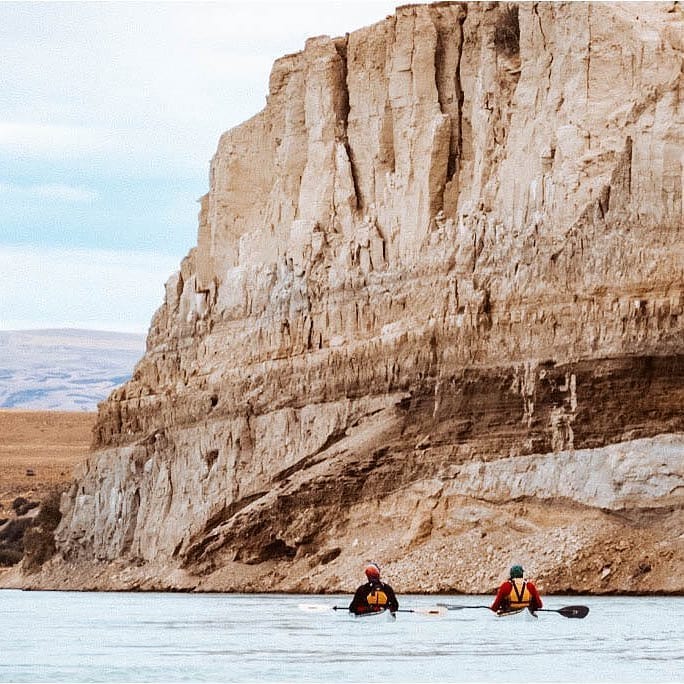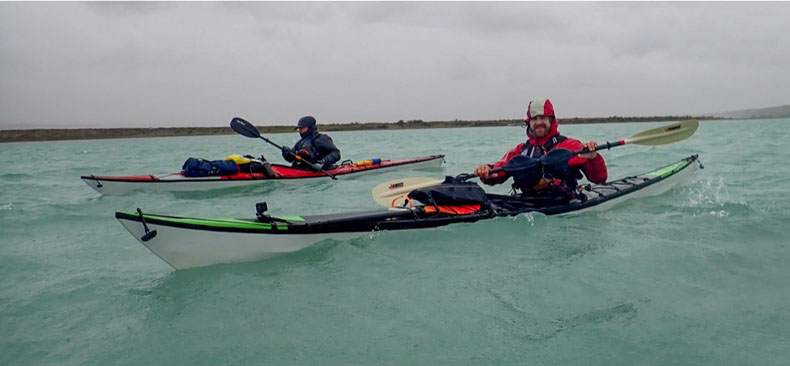|
Adventure Is Out There
Adventure is out there and it's waiting for you to answer its call. Expeditioning is like the edge of a blade; on one side you are in touch with the sharpness of the human experience which draws out who you are at a core level, allowing you to discover who I call your "inner wild" — someone primal that exists within all of us. On the other side, the reality is that we are exposing ourselves to the risks inherent to exploring very remote locations.
On the ferry to our Tierra Del Fuego Expedition launch.
My first awe-inspiring expedition brought me to the most mysterious lands in the Americas: Tierra Del Fuego — "The Land of Fire and Ice." I was so enthralled in the experience of visiting one of the most remote places left on Earth. Parry Fjord was a place like no other — lush mountains streaming with waterfalls like icy blue veins. We shared this space with no other humans — only a mature leopard seal which was hauled out on a sheet of ice only 30 feet off the bow of my kayak. I will never forget making eye contact with this stunning creature; it was in a singular moment that my experience shifted from enveloped curiosity to absolute eye-widening terror as she smiled back at me with her razor sharp teeth.
Finally got my hands on my folding TRAK. Photo by Zack Kruins. It was the autumn of 2018 when I started a new contract with Bigfoot Patagonia out of Puerto Natales, Chile, spending my season working out of Lago Grey, taking adventure travelers to see the beautiful Grey Glacier, one of the forty-eight glaciers that make up the Southern Patagonia Icefield, which happens to be the third largest reserve of frozen fresh water in the world. I was a little hesitant at first to paddle the TRAK 2.0 around the abundant ice in those waters, but I quickly realized the hull was built for rough hazards, and the adaptable rocker would allow me to weave between icebergs with ease.It could have been built specifically for paddling in Patagonia.
Icebergs in Lago Grey. Photo by Rodrigo Pizzaro.
I was enjoying the guide life on Lago Grey when I received an email from long-time TRAK Ambassador Zack Kruzins, who has paddled the TRAK farther than probably anyone else on earth. He invited me on an expedition he and his friend Ken Storm Jr. were planning. He told me it was an expedition into "deep time" — that caught my attention! Zack went on to explain that this expedition would take approximately 15 days and would cover 530km from the Andes to the Atlantic ocean. I was sold on the concept and it was the portability of the TRAK that would make our source-to-sea adventure to the Atlantic Coast possible.
Andes Sunrise. Photo by Ken Storm.
Gale force katabatic winds would force us to rely upon multiple modes of transportation to reach the Rio La Leona that begins 80 km south from the Viedma's West shore. Without a truly portable kayak we never would have been able to effectively transport our boats from Estancia Maria to Hotel Rio La Leona.
Cliffs along the Rio Santa Cruz, in the steppelands of Argentina. Photo by Ken Storm.
In April of 1834 Captain Robert Fitzroy led a 21-day expedition up the Rio Santa Cruz while the HMS Beagle was laid ashore on the Atlantic coast for repairs. Included on that expedition was the now-famous naturalist Charles Darwin — the tale of their exploration is worthy of many articles on its own. While navigating this river I spent a lot of time with Ken Storm Jr., a naturalist himself, who had brought with him not only an encyclopaedic knowledge of the local fossil record, but copies of Darwin's & Fitzroy's journals and illustrations from their expedition. We paddled the same route that Fitzroy walked, retracing their footsteps to famed locations such as Condor Cliff and Basalt Glen.
Paddling in squalls. Photo by Zack Kruzins. |
|
Top: TRAK 2.0 Kayak — ORIGIN Limited Edition. Bottom: Bagged up and ready to travel. |
Modern humans take expeditions as a way to re-connect to our primal roots. It is with deep respect for the traditional Qajaq that the team at TRAK has been creating skin-on-frame kayaks for over 15 years now. What I love most about paddling these boats is becoming one with the vessel while I move and adapt with the flowing and ever changing conditions — this keeps me in touch with the ultimate connection to myself and water. The portability and performance just happen to be perks of TRAK ownership.
|
|
A Note from the Graphic Designer The TRAK 2.0 ORIGIN design pays homage to the original skin on frame kayak and honors this history. The designs were influenced by humanity and optimism and I created the graphic elements to resemble LIFE at the core. The elements of the ORIGIN design will speak differently to each one of you, and everyone's interpretation of these designs is different, depending on your own individual experiences. This is the only kayak design out there of its kind. Not only a distinct portable kayak, the ORIGIN is a functional piece of art. — Dax Justin, Explorer and Artist. |
|
|
|
|
|
Cole Wilde is a TRAK Pilot-in-Residence, International Sea Kayak Guide, and founder of We Thrive Outdoors. |
|
|


